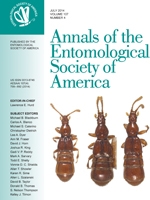Diaphania hyalinata L. (Lepidoptera: Crambidae) is a key pest of plants in the family Cucurbitaceae, defoliating and reducing photosynthetic area and yield. Trichospilus diatraeae Margabandhu & Cherian, 1942 (Hymenoptera: Eulophidae) parasitizes the pupae of this pest, but its biological and reproductive parameters with this host are unknown. The objective of our study was to characterize the reproduction of T. diatraeae in D. hyalinata pupae with different densities of this parasitoid. Individual D. hyalinata pupae (48 h old) were exposed to different densities of T. diatraeae (1:1, 4:1, 8:1, 12:1, 16:1, 20:1, and 24:1). The parasitoid density did not affect the parasitism and emergence rate of this natural enemy. The progeny, sex ratio, longevity, and head capsule width of T. diatraeae males and females decreased with increasing density, and its life cycle was proportional to density increase of T. diatraeae. Densities of up to eight T. diatraeae individuals per D. hyalinata pupae are favorable for the development of this parasitoid.
How to translate text using browser tools
1 July 2014
Density of Trichospilus diatraeae (Hymenoptera: Eulophidae) Parasitizing Diaphania hyalinata (Lepidoptera: Crambidae) Pupae
Isabel M. Silva,
Teresinha V. Zanuncio,
José M. M. Pereira,
Carlos F. Wilcken,
Fabricio F. Pereira,
José E. Serrão,
José C. Zanuncio
ACCESS THE FULL ARTICLE
It is not available for individual sale.
This article is only available to subscribers.
It is not available for individual sale.
It is not available for individual sale.
density
Eulophidae
mass rearing
parasitism





